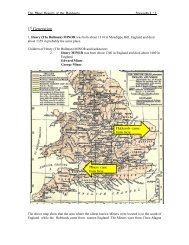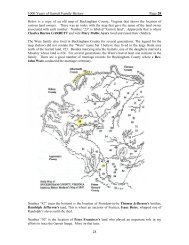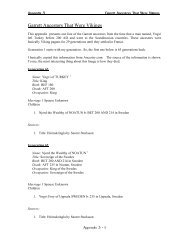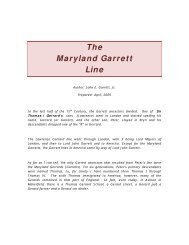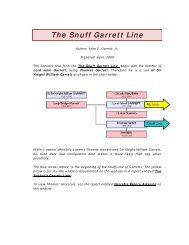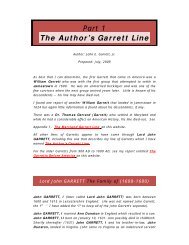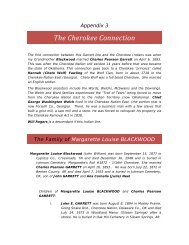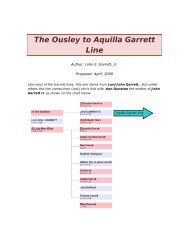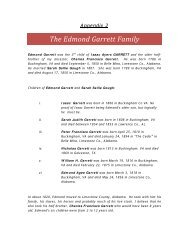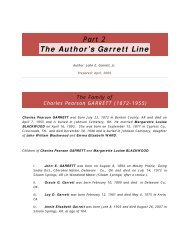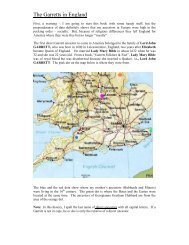the battle of Hastings - geraldini.com
the battle of Hastings - geraldini.com
the battle of Hastings - geraldini.com
Create successful ePaper yourself
Turn your PDF publications into a flip-book with our unique Google optimized e-Paper software.
Appendix 5 Battle <strong>of</strong> <strong>Hastings</strong><br />
Battle <strong>of</strong> <strong>Hastings</strong><br />
On September 27, 1066, Duke William <strong>of</strong> Normandy left St. Valery in<br />
Normandy with about 600 ships and 10,000 to 12,000 men.<br />
William and his barons had been recruiting and preparing <strong>the</strong> invasion <strong>of</strong><br />
England since early spring <strong>of</strong> that year. He was a seasoned general and master<br />
tactician, using cavalry, archers and infantry and had fought many notable<br />
<strong>battle</strong>s. Off Beachy Head, his ship, <strong>the</strong> Mora, arrived ahead <strong>of</strong> <strong>the</strong> fleet. As his<br />
fleet straggled into place behind him <strong>the</strong>y moved westward to <strong>the</strong> first sheltered<br />
bay to provide protection for his armada. Pevensey and Bulverhy<strong>the</strong> were <strong>the</strong><br />
villages on each promontory. Pevensey, to <strong>the</strong> west, was protected by an old<br />
Roman Fort and behind <strong>the</strong> fort <strong>the</strong>re was much flat acreage to house his large<br />
Army. To suggest this landing was not pre-planned, is not in keeping with <strong>the</strong><br />
preparatory time taken by William, or his track record. There had been much<br />
intelligence ga<strong>the</strong>ring in <strong>the</strong> past few months. See map below.<br />
The bay, wide enough for maneuverability <strong>of</strong> this large fleet, was flat<br />
shored. William is said to have fallen on <strong>the</strong> beach, grasped <strong>the</strong> sand, and<br />
declared "This is my country" or words to that effect. Next, <strong>the</strong> ships were<br />
disembarked without resistance. They included 2,500 horses, prefabricated forts,<br />
and <strong>the</strong> materiel and equipment was prepared for any contingency. The ships<br />
shuttled in and out <strong>of</strong> <strong>the</strong> bay with <strong>the</strong> precision <strong>of</strong> a D Day landing. A Fort was<br />
built inside Pevensey Roman Fort as an H.Q, while <strong>the</strong> army camped behind it.<br />
William and FitzOsborn scouted <strong>the</strong> land He was unhappy with <strong>the</strong> terrain but it<br />
had proved to be a satisfactory landing beach. Taking his army around Pevensey<br />
Bay he camped 8 miles to <strong>the</strong> east, north <strong>of</strong> what is now known as <strong>Hastings</strong> all <strong>of</strong><br />
which was most likely pre-planned. He camped to <strong>the</strong> east outside <strong>the</strong> friendly<br />
territory <strong>of</strong> <strong>the</strong> Norman Monks <strong>of</strong> Fecamp who may have been alerted and were<br />
Appendix 5 – Page 1
Appendix 5 Battle <strong>of</strong> <strong>Hastings</strong><br />
waiting for his probable arrival. William waited. Perhaps he was waiting to know<br />
<strong>of</strong> <strong>the</strong> out<strong>com</strong>e <strong>of</strong> <strong>the</strong> <strong>battle</strong> to <strong>the</strong> north. In those two weeks William could have<br />
marched on London and taken it. He was obviously waiting for something?<br />
Harold, far to <strong>the</strong> north in York at Stamford Bridge, was engaged in a life<br />
and death struggle against his bro<strong>the</strong>r who had teamed up with <strong>the</strong> Viking King<br />
Hadrada to invade England. Whe<strong>the</strong>r this was a planned Norman tactic, part <strong>of</strong> a<br />
pincer movement north and south, is not known, but students <strong>of</strong> Norman and<br />
Viking history might find it very feasible. The timing <strong>of</strong> each invasion was<br />
impeccable, and probably less than coincidental. Harold managed to resist <strong>the</strong><br />
invasion to <strong>the</strong> north and killed both <strong>com</strong>manders. He was advised <strong>of</strong> <strong>the</strong> landing<br />
to <strong>the</strong> south by William.<br />
Bringing <strong>the</strong> remnants <strong>of</strong> his Army south, Harold camped outside<br />
London at Waltham. For two weeks he ga<strong>the</strong>red reinforcements, and exchanged<br />
taunts, threats and counterclaims to <strong>the</strong> Crown <strong>of</strong> England with William. Finally<br />
he moved his army south to a position about six miles north <strong>of</strong> where William<br />
waited.<br />
Perhaps one <strong>of</strong> <strong>the</strong> most devastating events preceding <strong>the</strong> <strong>battle</strong> was<br />
Harold's sudden awareness that he had been ex<strong>com</strong>municated by <strong>the</strong> Pope, and<br />
that William was wearing <strong>the</strong> papal ring. William was leading what might<br />
perhaps by called <strong>the</strong> first Crusade. The whole world was against Harold.<br />
William moved up to Harold's position and set up in what was <strong>the</strong>n <strong>the</strong><br />
conventional European style. Archers, infantry and cavalry in <strong>the</strong> rear.<br />
Harold waited. He and his bro<strong>the</strong>r Gyrth arranged a mass <strong>of</strong> men along a<br />
high ground ridge 8 deep, 800 yards long . A fixed corridor <strong>of</strong> tightly wedged<br />
humanity. Strategically, given <strong>the</strong> relative equipment <strong>of</strong> each side, it was<br />
hopeless from <strong>the</strong> start. To William it was almost a formality. Harold's men were<br />
hemmed in by <strong>the</strong>ir own elbows. William, with total mobility, held his Breton,<br />
Maine and Anjou contingents to <strong>the</strong> left <strong>of</strong> <strong>the</strong> line, <strong>the</strong> Normans <strong>the</strong> main thrust,<br />
<strong>the</strong> Flemish and French to his right. The flanking movements paid <strong>of</strong>f. How long<br />
<strong>the</strong> <strong>battle</strong> took has varying estimates. Some say as little as two hours. Some as<br />
long as six hours. The latter seems more reasonable simply because <strong>of</strong> <strong>the</strong><br />
numbers involved.<br />
This <strong>battle</strong> would later be called Senlac, a river <strong>of</strong> blood. It demolished<br />
most <strong>of</strong> <strong>the</strong> remnants <strong>of</strong> <strong>the</strong> Saxon fighting men <strong>of</strong> <strong>the</strong> Island at very little cost to<br />
William.<br />
Harold was slain. He was probably run through by William's lance.<br />
Appendix 5 – Page 2



